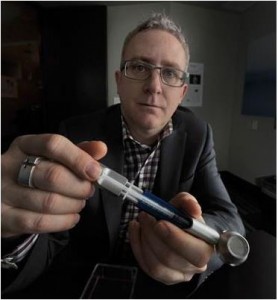As Seen In
The Province: Four Biotech Companies that are Helping B.C. Lead the Battle Against Aging

To read the full article on The Province newspaper website click here\n
\nA Vancouver-based anti-aging company is betting that the fountain of youth flows with antifreeze produced by an Antarctic fish.
\nSirona Biochem has synthesized compounds from glyco-proteins made by the Nototenioid that enable the homely but hardy fish to survive in sub-zero temperatures.
\nThe company has created an age-busting technology to protect people’s skin and restore its youthfulness, says Attila Hajdu, Sirona’s chief business development\n officer.
\n“We’ve developed an anti-aging compound that has been scientifically proven to extend cell life and prevent cell death,” Hajdu says.
\n“It’s remarkably exciting.”
\nSirona belongs to a group of B.C. age-busters at the cutting edge of the global push to help people live longer.
\nMany B.C. residents would be “shocked and dumbfounded” to learn that companies in their own backyard are making real progress in extending people’s lives,\n says Paul Drohan, president-CEO of
\nLifeSciences B.C., a Vancouver-based industry association.
\nNot content to simply give people more years, B.C. biotech companies are responding to boomers’ desire to age gracefully by staying healthy and active,\n Drohan says.
\n“The idea is to keep people on their bikes and paddle boards longer, to keep them running longer, and looking good while they’re doing it,” Drohan says.
\nIt’s no accident B.C. companies are at the leading edge of anti-aging research.
\nThe province has top-notch biotech talent and a good track record for “translation” — taking lab discoveries and turning them into commercial products,\n Drohan says.
\nThe province scored an early victory in the anti-aging war in the late 1980s when Vancouver ophthalmologist Jean Carruthers and Alastair Carruthers, her\n dermatologist husband, discovered the cosmetic powers of a toxin called Botox in easing lines and wrinkles.
\nB.C. seniors’ appetite for anti-aging products or therapies has only grown.
\nThe province already has the longest average life expectancy in Canada — 84 for women, versus the national average of 83; 80 for men, against the\n national average of 79.
\n“We probably have one of the most active elderly populations in the country,” Drohan says.
\n“They’ve made sure they’ve lived a healthy life and they’re interested in advances in anti-aging and regenerative medicine.”
\nVancouver is a pinpoint in the global anti-aging market. U.S.-based firm BCC Research estimates that people over 65 will make up 12 per cent of the world’s\n market by 2030, up from seven per cent in 2010.
\nAs the planet’s population ages, the global market for anti-aging products is soaring.
\nBCC expects the worldwide market for anti-aging cosmetic and pharmaceutical products to climb to $345.8 billion US in 2018 from $249.3 billion in 2012.
\nThe related market for regenerative medicine, which aims to restore functional ability to tissues and organs, should explode to $67.6 billion US in 2020\n from $16.4 billion in 2013, according to a separate report.
\nB.C.’s anti-aging companies want to grab a piece of this action.
\nBut the field is fraught with risk as companies spend years demonstrating to regulators their products are safe and effective, Drohan says.
\n“Some discoveries will turn into huge commercial successes and some, unfortunately, will not prove their end points,” he says.
\nIt can take 10 years for a product to pass clinical trials and be approved by regulators as being market-ready.
\nFollowing are four B.C. companies that already have anti-aging products or are well along the way to putting them on the market.
\nBALDNESS TREATMENT IN THE WORKS\n 
RepliCel Life Sciences wants to turn back the clock on how you look and how you feel.
The Vancouver-based company is exploring the frontiers of regenerative medicine to treat injured tendons, pattern baldness and skin damaged by sun and\n age.
\nThe world’s scientists have advanced from using chemical compounds to proteins and antibodies in their bid to reverse age-triggered wear and tear, says\n Lee Buckler, RepliCel’s vice-president of business and corporate development.
\n“We are the next wave of biotechnology. We use cells as medicines. We call this cell therapy,” Buckler says. “We’ll not only keep people looking younger\n but acting younger. It’s as much a matter of keeping the guy on the golf course as it is looking good while he’s golfing.”
\nAt the core of RepliCel’s age-busting technology are cells called fibroblasts extracted from a patient’s own hair follicles. Fibroblasts produce Type 1\n collagen, a protein that helps the body repair skin and connective tissue.
\n“It’s like personalized medicine. You don’t have to pump yourself full of synthetics anymore. This uses your own cells.”
\nInjections of fibroblasts have been proven in the lab to help tendons repair themselves, reduce wrinkles and tone up skin, Buckler says. A different set\n of cells extracted from follicles is used to regenerate hair.
\nThe company has embarked on an aggressive program of trials on human subjects to prove to health regulators its approaches are safe and effective.
\nThe need for three sets of trials for each therapy means RepliCel’s therapies are several years away from reaching the North American market, Buckler says.
\nRepliCel scored a coup in 2013 when it formed a partnership with Japanese cosmetic giant Shiseido. That partnership, and Japanese regulatory changes, mean\n RepliCel’s pattern baldness treatment will likely reach the Japanese market sooner than anywhere else, Buckler says.
\nFormed in 2010, RepliCel trades on the TSX venture exchange and employs about a dozen people.
\nSAVING FACE\n
\nThe first battleground in Sirona Biochem’s fight against aging is the mirror.
\nThe Vancouver-based company is developing anti-aging products based on the antifreeze produced by an Antarctic fish to protect and regenerate human skin,\n says Attila Hajdu, the company’s chief business development officer.
\n“Everyone looks in the mirror. If we help make them happier with what they see then we’re improving their lives,” Hajdu says.
\nThe chemical compounds that Sirona has synthesized based on the fish’s glyco-proteins go beyond their power to lighten skin and protect it from the impact\n of age and sun damage.
\nThe synthesized compounds’ cell-preserving powers also mean they can be used in organ and tissue transplants, Hajdu says.
\nThe company has licensed its compounds to companies around the world in return for fees and royalty payments.
\nSirona, which began in 2009, employs 15 people and trades on the TSX venture and Frankfurt stock exchanges.
\nIt conducts research at a laboratory in France.
\nFUELLING STEM CELL RESEARCH\n
\nVancouver-based Stemcell Technologies hands global scientists the tools they need to help people live longer.
\nStemcell has become Canada’s largest biotech company by selling nutritious soup — technically, it’s called “tissue culture media” — that scientists\n need to grow specialized stem cells for anti-aging research.
\n“We provide the picks and shovels for the regenerative medicine gold rush,” says CEO and owner Allen Eaves.
\nScientists, who obtain stem cells from sources such as skin and blood, use the company’s products to research cell therapies for everything from diabetes\n to Parkinson’s disease.
\nTissue engineering to regenerate organs is an area of intense research.
\n“When you have kidney failure, ideally, you will be able to engineer and construct a replacement kidney using a patient’s own cells rather than looking\n for a donor,” Eaves says.
\nEaves founded the company in 1993 as a spinoff from the Terry Fox Laboratory at the B.C. Cancer Agency. It employs 650 people, 500 of whom are in Vancouver.
\nStemcell sells products to about 70 countries. It has annual revenues of about $100 million and has been profitable since its launch. The company has committed\n $350 million to research and development over the next 10 years.
\nHALTING A RENEGADE ENZYME\n
\nViDA Therapeutics is working to help people shake off the effects of age by sticking a sock in the mouth of one of the body’s trickiest frenemies.
\nThe immune system produces an enzyme called granzyme B to target and kill infected cells. So far, so good.
\nBut several years ago researchers at Vancouver’s St. Paul’s Hospital found high levels of granzyme B outside of cells in aged and damaged human skin. They\n also discovered high levels of the enzyme in the occurrence of other ailments such as rheumatoid arthritis, fibrosis and heart disease.
\nKnowing they were on a promising path, research scientist and University of B.C. professor Dave Granville joined forces with Vancouver biotechnology veteran\n Alistair Duncan in 2008 to launch viDA.
\nSince then, viDA’s research team has developed a library of molecular compounds to inhibit granzyme B.
\n“Granzyme B is running amok and causing damage from rheumatoid arthritis to heart conditions to neural inflammation,” Duncan says. “If you picture granzyme\n B as a Pac-Man that goes around gobbling, we stick a sock in its mouth so it can’t gobble anymore, allowing the healing process to begin.”
\nPrivately owned viDA is focused on research to develop a cream to tackle skin aging and discoid lupus erythematosus, an auto-immune disease aggravated\n by sunlight that can cause facial scarring. Pop musician Seal has this condition.
\nViDA is also exploring how its granzyme B inhibitors may be used to treat other diseases such as aneurysms and chronic obstructive pulmonary disease.
\nGetting a skin treatment through the regulatory pipeline to market may take seven to eight years, Duncan says.\n
Given that granzyme B levels rise with age, baby boomers may wish to pay attention.\n
pluke@theprovince.com\n
twitter.com/ProvMoney\n
© Copyright (c) The Province
by Topic
DISCLAIMER:
The information in these press releases is historical in nature, has not been updated, and is current only to the date indicated in the particular press release. This information may no longer be accurate and therefore you should not rely on the information contained in these press releases. To the extent permitted by law, RepliCel Life Sciences Inc. and its employees, agents and consultants exclude all liability for any loss or damage arising from the use of, or reliance on, any such information, whether or not caused by any negligent act or omission.
THIRD PARTY CONTENT
Please note that any opinion, estimates or forecasts made by the authors of these statements are theirs alone and do not represent opinions, forecasts or predictions of RepliCel Life Sciences Inc. or its management. RepliCel Life Sciences Inc. does not, by its reference or distribution of these links imply its endorsement of, or concurrence with, such information, conclusions or recommendations.